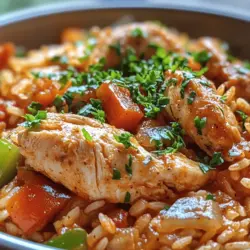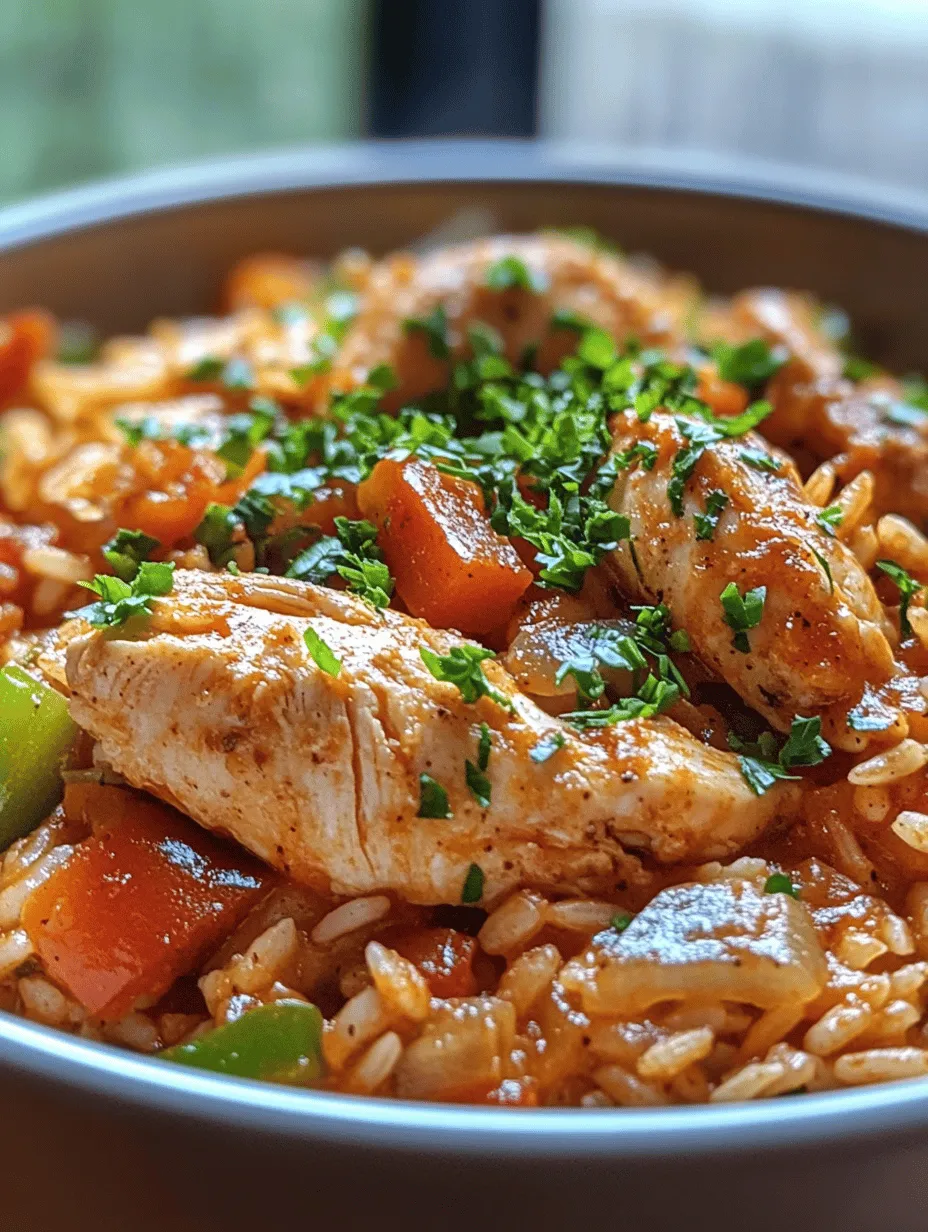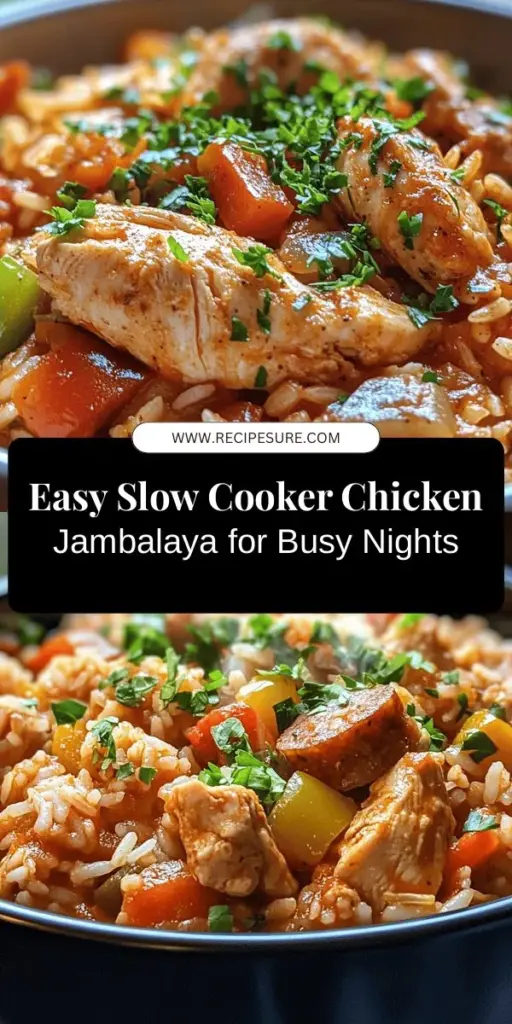Introduction
Jambalaya is a beloved dish with deep roots in Louisiana cuisine, embodying the vibrant flavors and cultural heritage of the South. This iconic one-pot meal combines a medley of ingredients that come together to create a hearty and satisfying dish, perfect for family gatherings or cozy dinners. Traditionally, jambalaya features a combination of proteins, vegetables, and spices, all simmered with rice to absorb the rich flavors.
In our fast-paced lives, the slow cooker method provides an excellent solution for busy cooks who still want to enjoy this classic dish. The slow cooker allows the flavors to meld beautifully while freeing you up to attend to other tasks. With minimal prep work, you can set your slow cooker and let it do the magic, resulting in a delicious jambalaya that’s both comforting and nutritious.
This specific recipe for Slow Cooker Chicken Jambalaya stands out for its hearty flavors, ease of preparation, and nutritional balance. With tender chicken, smoky sausage, and a rich blend of spices, this dish is sure to impress your family and friends. Plus, it’s an adaptable recipe that can cater to your personal taste preferences and dietary needs.
Understanding Jambalaya
Historical Context of Jambalaya
Jambalaya has a rich history that reflects the cultural influences of Louisiana. The dish is thought to have originated from Spanish paella, which was adapted by Creole cooks who added local ingredients such as rice, seafood, and meats. Over time, jambalaya evolved into a distinct culinary icon that is enjoyed in homes and restaurants throughout the region.
The dish signifies the melting pot of cultures in Louisiana, merging influences from African, Spanish, French, and Caribbean cuisines. Whether served at festive gatherings or family meals, jambalaya holds a special place in the hearts of many, embodying the spirit of community and hospitality.
Variations of Jambalaya
There are two primary variations of jambalaya: Cajun and Creole. Cajun jambalaya, often referred to as “brown jambalaya,” typically emphasizes a darker color from browning the meats and vegetables. It’s characterized by a more rustic approach, using ingredients that are readily available in rural areas. On the other hand, Creole jambalaya, or “white jambalaya,” includes tomatoes and has a lighter color. It often features a wider variety of seafood and is more refined in flavor.
This Slow Cooker Chicken Jambalaya recipe leans towards the Cajun style, focusing on hearty meats and bold spices that create a deeply satisfying dish. The slow cooking process allows the flavors to deepen and develop, resulting in a truly authentic taste experience.
Ingredients that Define Jambalaya
At the heart of every jambalaya are its ingredients, each playing a vital role in contributing to the dish’s overall flavor and texture. The key components include:
- Proteins: Chicken and sausage are typically the stars of jambalaya. Chicken thighs are often preferred for their tenderness and ability to retain moisture during cooking. Andouille sausage, a smoked sausage with Cajun roots, adds an essential smoky flavor that enhances the dish.
- Vegetables: The “Holy Trinity” of Cajun and Creole cooking comprises onions, bell peppers, and celery, forming the aromatic base of the dish. Garlic also plays a crucial role, adding depth and flavor.
- Rice: Long-grain white rice is the preferred choice for jambalaya. It cooks evenly and absorbs the flavors of the broth without becoming mushy.
- Spices and Seasonings: A blend of Cajun seasoning, thyme, paprika, and bay leaves contributes to the dish’s distinctive flavor profile. The spices create a warm, aromatic essence that is characteristic of Southern cooking.
- Optional Ingredients: Some variations of jambalaya include frozen peas for a pop of color and freshness, while fresh parsley can be used as a garnish to brighten the dish.
Ingredients Breakdown
To create a delicious Slow Cooker Chicken Jambalaya, you’ll need the following ingredients, each carefully selected for its contribution to the overall flavor and texture of the dish:
Chicken Thighs
Using chicken thighs instead of breast meat is a game-changer in this recipe. Thighs are more forgiving during the slow cooking process, as they remain tender and juicy, soaking up the surrounding flavors. They contain higher fat content, which enhances the richness of the dish and prevents the meat from drying out.
Smoked Sausage
Andouille sausage is a staple in most jambalaya recipes, providing that essential smoky flavor that distinguishes this dish. The rich, spicy notes of andouille complement the other ingredients beautifully, creating a well-rounded taste. If you cannot find andouille sausage, any smoked sausage can serve as a suitable substitute, though it may alter the flavor profile slightly.
Vegetables: The Holy Trinity
The combination of onion, bell pepper, and celery is often referred to as the “Holy Trinity” in Cajun and Creole cooking. This aromatic trio forms the flavor foundation of jambalaya.
- Onion: Provides sweetness and depth of flavor.
- Bell Pepper: Adds a slight crunch and a burst of color.
- Celery: Brings earthiness and a subtle crunch.
Garlic is also included for its pungent, savory flavor, which enhances the overall aroma of the dish.
Rice
Long-grain white rice is the best choice for jambalaya. It cooks evenly and absorbs the flavorful broth without becoming sticky. This type of rice helps maintain the dish’s texture, ensuring each bite is filled with perfectly cooked grains that pair well with the other ingredients.
Spices and Seasonings
Spices are the heart of jambalaya, and using a well-balanced mix is essential for achieving that authentic flavor.
- Cajun seasoning: A blend of spices that typically includes paprika, cayenne pepper, garlic powder, onion powder, and black pepper. This seasoning brings heat and complexity to the dish.
- Thyme: Adds a subtle earthy flavor that complements the meat and vegetables.
- Paprika: Provides a mild sweetness and rich color to the jambalaya.
You may also want to include bay leaves during the cooking process for added depth of flavor.
Optional Ingredients
While not mandatory, adding frozen peas at the end of cooking can introduce a nice burst of color and sweetness. Fresh parsley can be used as a garnish to add a touch of brightness and freshness to the final dish.
Preparation Steps
Now that you’re familiar with the history and ingredients of this Slow Cooker Chicken Jambalaya, let’s dive into the preparation steps. The following guide will take you through the process, ensuring you create a delectable dish that is packed with flavor and sure to satisfy.
Step 1: Seasoning the Chicken
Proper seasoning is crucial for infusing flavor into the chicken and ensuring it doesn’t taste bland. Start by patting the chicken thighs dry with paper towels to remove excess moisture, which helps in browning. Then, generously season both sides with Cajun seasoning, salt, and pepper. This step is vital as it allows the spices to penetrate the meat, enhancing its flavor during the slow cooking process.
Step 2: Sautéing the Vegetables (Optional)
If you have time, consider sautéing the onions, bell peppers, celery, and garlic in a skillet before adding them to the slow cooker. This optional step caramelizes the vegetables, intensifying their natural flavors and adding a lovely sweetness to the dish.
Heat a tablespoon of oil in a skillet over medium heat, then add the chopped vegetables. Sauté for about 5-7 minutes, or until the onions are translucent and the peppers have softened. This extra step can elevate the overall taste of your jambalaya, but if you’re short on time, you can simply add the raw vegetables directly to the slow cooker.
Step 3: Layering the Ingredients in the Slow Cooker
Once the chicken is seasoned and the vegetables are prepared, it’s time to layer the ingredients in your slow cooker. Start by placing the seasoned chicken thighs at the bottom of the pot. This allows the meat to absorb the flavors of the broth as it cooks. Next, add the sautéed vegetables (if you chose to sauté them) over the chicken.
Then, sprinkle in the rice evenly on top of the vegetables, followed by the sliced smoked sausage. Finally, pour in the chicken broth, ensuring that the rice is fully submerged in the liquid. This balance of liquid to rice is essential for achieving the perfect texture.
Step 4: Adding Spices
Before closing the lid, don’t forget to add your spices! Sprinkle the Cajun seasoning, thyme, and paprika over the top of the mixture. Add the bay leaves for an aromatic touch. Stir gently to combine the ingredients, but be careful not to disturb the layer of rice too much.
Step 5: Cooking the Jambalaya
Cover the slow cooker and set it to cook on low for 6-7 hours or on high for 3-4 hours. The slow cooking method allows the flavors to meld together beautifully, creating a dish that is rich and satisfying. During the last 30 minutes of cooking, if desired, you can add frozen peas for a pop of color and sweetness.
In the next part of the article, we’ll delve into the finishing touches and tips for achieving the best results with your Slow Cooker Chicken Jambalaya. We’ll also address some common questions to help you navigate this delightful dish with ease. Stay tuned for more culinary insights!

Layering the Ingredients: How Layering Affects Cooking and Flavor Infusion
When preparing Slow Cooker Chicken Jambalaya, the order in which you layer your ingredients is essential for maximizing flavor and ensuring even cooking. Begin with a foundation of aromatic vegetables—typically onions, bell peppers, and celery (often referred to as the “Holy Trinity” in Cajun and Creole cooking). These vegetables should be placed at the bottom of the slow cooker, where they can develop their flavors and release their natural juices, creating a flavorful base from which the rest of the ingredients can draw.
Next, add the proteins. In this case, chicken and sausage are ideal. By placing the meat on top of the vegetables, the proteins will cook in the moisture released by the vegetables while also allowing their flavors to seep down, infusing the entire dish. You should then layer any other ingredients, such as rice and spices, ensuring that the seasoning is well distributed throughout.
Finally, the liquids (chicken broth and diced tomatoes) should be added last. This method of layering not only ensures that each component cooks evenly but also allows for the spices to intermingle and the flavors to intensify, resulting in a rich and robust jambalaya.
Adding Liquids: The Role of Chicken Broth and Tomatoes in Creating a Flavorful Base
The liquids you choose for your Slow Cooker Chicken Jambalaya are crucial for developing depth in the dish. Chicken broth serves as the primary liquid, imparting a savory depth that complements the chicken and sausage perfectly. Opt for low-sodium broth to better control the salt levels in your dish, especially since sausages can often be salty.
Diced tomatoes, whether fresh or canned, add acidity and sweetness that balance the richness of the meats and the spices. When combined with the broth, the tomatoes help to create a flavorful cooking medium that allows the rice to absorb all the delicious flavors as it cooks. The tomatoes also contribute a beautiful color to the jambalaya, making it visually appealing and inviting.
Slow Cooking Process: Explanation of Low vs. High Settings and Their Effects on the Dish
Understanding the slow cooking process is essential for achieving the best results with your jambalaya. Slow cookers typically have two temperature settings: low and high. Cooking on the low setting usually takes around 6 to 8 hours, while the high setting will cook the dish in approximately 3 to 4 hours.
For Slow Cooker Chicken Jambalaya, using the low setting is ideal. This allows the flavors to meld beautifully over time, creating a rich and complex taste. Cooking on low also ensures that the proteins remain tender and juicy, preventing them from drying out. Conversely, the high setting can be used in a pinch, but it may result in a less developed flavor profile and a slightly firmer texture in the rice.
Cooking Tips for Optimal Flavor
To ensure that your Slow Cooker Chicken Jambalaya reaches its full flavor potential, consider the following tips:
1. Timing and Temperature: The key to successful slow cooking lies in maintaining the right temperature and cooking time. Low and slow is the mantra for rich, deeply flavored dishes. If you’re constrained for time, opt for the high setting but closely monitor your dish to prevent overcooking.
2. Ingredient Substitutions or Additions: Jambalaya is highly adaptable. If you’re looking to switch up the proteins, consider using shrimp or smoked turkey. Additionally, you can incorporate different vegetables such as okra, zucchini, or corn. These additions can enhance the nutrition and flavor profile without compromising the dish’s authenticity.
3. Adjusting the Heat Level: If you enjoy a bit of heat, consider adding diced jalapeños or a dash of cayenne pepper for a spicier jambalaya. For a milder version, reduce the amount of cayenne or omit it altogether. Always taste as you go to ensure the heat level matches your personal preference.
Nutritional Insights
Slow Cooker Chicken Jambalaya not only satisfies the taste buds but also provides a well-rounded nutritional profile.
- Protein Content from Chicken and Sausage: The dish is a great source of protein, thanks to the chicken and sausage. Chicken breast is lean, while sausage adds flavor and richness. For a healthier option, consider using turkey sausage or chicken sausage, which can lower the fat content without sacrificing taste.
- Fiber and Vitamins from Vegetables: The inclusion of bell peppers, onions, and celery not only adds flavor but also provides essential vitamins and dietary fiber, promoting good digestion and overall health.
- Balanced Meal Considerations and Portion Control: Jambalaya can serve as a complete meal in itself, but portion control is critical. A standard serving of jambalaya is about one cup, which provides a balanced mixture of protein, carbohydrates from the rice, and vegetables. Pair it with a fresh side salad to increase your vegetable intake and enhance the meal’s nutritional value.
Serving Suggestions
To make the most of your Slow Cooker Chicken Jambalaya, consider these serving suggestions:
- Complementary Sides: Traditional side dishes that pair well with jambalaya include cornbread, which adds a delightful sweetness and texture contrast, or a simple green salad dressed with a light vinaigrette for freshness. A side of steamed vegetables can also enhance the meal’s nutrition.
- Presentation Tips: When serving, use a large spoon to scoop the jambalaya into bowls or onto plates. Garnish with freshly chopped parsley or green onions for a pop of color and freshness. If desired, serve with lemon wedges on the side, allowing guests to squeeze fresh juice over their dish for added brightness.
- Beverage Pairings: For beverage pairings, consider serving the jambalaya with a crisp white wine, such as Sauvignon Blanc, which complements the spices beautifully. Alternatively, a light lager or a refreshing iced tea can also be excellent choices that enhance the meal experience.
Conclusion
In conclusion, Slow Cooker Chicken Jambalaya is a delightful dish that combines rich flavors, hearty ingredients, and the convenience of slow cooking. It’s an excellent choice for busy weeknights or gatherings, offering a comforting and satisfying meal that can cater to various tastes and dietary preferences.
The layered cooking method and thoughtful ingredient choices ensure that each bite is bursting with flavor, while the nutritional benefits make it a smart choice for a wholesome meal. Embracing the slow cooking method allows you to create dishes that are not only easy to prepare but also deeply satisfying and full of character. So gather your ingredients, set your slow cooker, and enjoy the delightful aromas that fill your home as you prepare a dish that is sure to impress family and friends alike.


